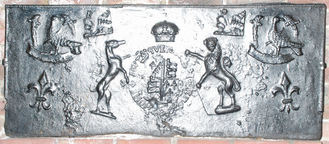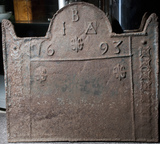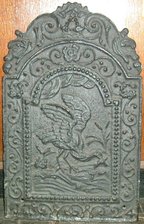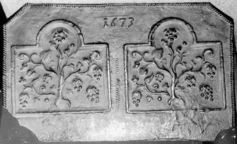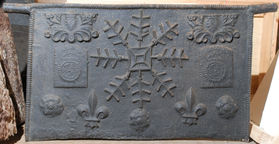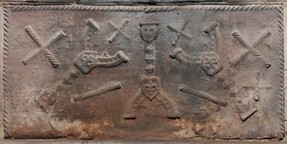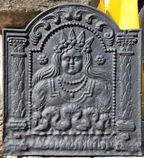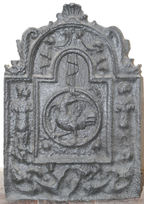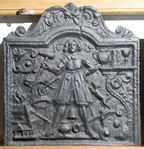-
10
Description: Rectangular; rope edging (top and sides); central Tudor royal shield with encircling garter (motto reversed: HONE SOVT QVEY … PEN), separate greyhound and lion supporters, separate crown; a bird, repeated in each top corner, its wings displayed and inverted and its head facing behind and to the left, standing on a scroll; a fleur de lys repeated in the bottom corners; inside the birds is a repeated stamp, half of one similar to a stamp on a fireback in Hastings Museum.
Notes: The particular form of the Tudor arms and supporters is encountered on other firebacks, as are the distinctive style of fleurs de lys and the birds (probably swans, a Lancastrian icon). The plain scroll upon which the bird is perched suggests that there might have been a painted inscription on it originally and that the stamp had not been made specifically for the decoration of firebacks but was, perhaps, redundant from interior domestic decoration. Formerly at Framfield, East Sussex.
Arms: Tudor royal (prob. Henry VIII)
- Decoration tags:
- rectangular (shape)
- rope (edging)
- carved stamps
- heraldic
- armorial
- royal
- objects
Manufactured: in the early- to mid-16th century possibly at Pounsley Furnace, Framfield in the Weald area of England.
Current location: The Clergy House, Alfriston, East Sussex, England.
Museum number: 200044 (part of the National Trust museum group)
-
1142
Description: Arched rectangular shape with quadrant extensions on top corners; twisted rope edging (top and sides); vertical rope line parallel to each side, forming two separate side panels; horizontal rope line joined to vertical lines enclosing the following: inside arch, initials IBA in triad; below initials, double fleur-de-lys stamp between split date; below horizontal line, a double fleur stamp in each top corner of central lower panel; in each side panel, a single bead above a vertical sequence of squared cross stamps repeated eight times.
Notes: The distinctive squared cross and fleur stamps are seen on other firebacks; the initials in triad may relate to a husband and wife. A taller variant of the same fireback is at Northgate House, Warwick. Mendip Auctions, Binegar, Somerset, 7 Sep 2019, lot 374.
Inscription: IBA [triad] / 16 93
- Decoration tags:
- rectangular with round arch (shape)
- rope (edging)
- simple stamps
- carved stamps
- individual letters
- individual numbers
- objects
Manufactured: in 1693 in the Forest of Dean area of England.
Current location: not known.
- Attached to series:
- Newent area group
- Square cross Dean series 2
- Fleur-de-lys firebacks
-
1268
Description: Quasi-arched shape with forward-facing 'wings', which splay outwards towards the base; the 'wings' curve to follow the shape of the main panel but curl outwards at the top; central panel with stylised image of a tree; top centre, three ostrich feathers gathered at their quills, on either side of which, on the curled upper parts of the 'wings', are a mirrored feature of uncertain type.
Notes: Nothing is known about the sources of free-standing firebacks or what prompted their production. Their form is similar and the predominant use of horticultural or arboreal decorative themes suggests production within a limited time frame. Only a very small number of such castings are known. Depth 210mm. The fireback has been repaired in the main panel and attached to a later grate.
- Decoration tags:
- free-standing (shape)
- none (edging)
- whole carved pattern
- plants
- objects
Manufactured: in the late-17th to early-18th century in England.
Current location: Bramshill House, Bramshill, Hampshire, England.
- Attached to series:
- Free-standing firebacks
-
82
Description: 'Dutch' style; arched rectangular shaped central panel, bead on fillet edging, naturalistic scene of a heron with wings extended catching a fish, water below, clouds above, plants in background; arched rectangular shaped border, fillet edging, symmetrical scrolled tendril pattern; at bottom, two looped 'W' figures between date split corners; on top, symmetrical scrolled foliage. A single central vertical plankline.
Notes: The image of the heron is taken from a print, by Wenceslaus Hollar c.1658, of an etching by Francis Barlow (c.1626-1704); the style of the date suggests a similar pattern maker to a series of firebacks, of the same date, some bearing a Welsh inscription. All incorporate the looped 'W' motif which may be intended to identify the pattern maker. The small size of this fireback makes it likely that it was intended to be fixed to the back of a grate.
Copies of this fireback are known.
Inscription: 17 24
- Decoration tags:
- 'Dutch' (shape)
- fillet (edging)
- whole carved pattern
- planklines
- pictorial
- text
- animals
Manufactured: in 1724 in England.
Current location: Guildford Museum, Guildford, Surrey, England.
Museum number: G.487 (part of the Guildford Museum museum group)
- Attached to series:
- 1724 series
- British 'Dutch' style firebacks
-
129
Description: Canted rectangle; twisted rope edging (top and sides); date stamp top centre; arched rectangular style fireback with cavetto-moulded edge and fructed ‘vine’ plant design, impressed twice; vertical twisted rope length between. Damage to bottom corners.
Notes: A composite fireback using the impressions of another fireback repeated for a symmetrical design. Formerly part of the Ade Collection (from Grove Hill, Hellingly, Sussex).
Inscription: 1673
- Decoration tags:
- rectangular with canted top corners (shape)
- rope (edging)
- composite
- date stamp
- text
- plants
- objects
Manufactured: in 1673 in the Weald area of England.
Current location: Hastings Museum and Art Gallery, John's Place, Bohemia Road, Hastings, East Sussex, England.
Museum number: HASMG: 1952.51.65 (part of the Hastings Museum museum group)
- Attached to series:
- Composite firebacks
- Small cavetto series
-
131
Description: Rectangular with lifting handles; twisted rope edging (top and sides); elaborate central rope design of concentric squares with eight symmetrical arms each with six branches; two crowned rose en soleil stamps left and right centre; three roses across the bottom interspersed with two fleurs de lys; in top corners, two carved furniture-derived stamps. The width of the main plate is 876mm.
Notes: The rose-en-soleil was the badge of King Edward IV and, thus, a Yorkist symbol. The individual stamps are to be seen, separately or together, on other firebacks, indicating a common source; lifting handles are infrequently encountered on firebacks. The elaborate central rope array may be an interpretation of the escarbuncle, which was the principal heraldic charge on the arms of the Duchy of Cleves (1515-57), possibly associating this fireback with the brief marriage of Henry VIII and Anne of Cleves. Formerly part of the Ade Collection (from Grove Hill, Hellingly, Sussex).
- Decoration tags:
- rectangular (shape)
- rope (edging)
- simple stamps
- carved stamps
- lifting handles
- heraldic
- architectural
- objects
Manufactured: in the mid- to late-16th century possibly at Pounsley Furnace, Framfield in the Weald area of England.
Current location: Hastings Museum and Art Gallery, John's Place, Bohemia Road, Hastings, East Sussex, England.
Museum number: HASMG: 1952.51.44 (part of the Hastings Museum museum group)
-
912
Description: Rectangular; twisted rope edging (top and sides); impression of the end of a firedog repeated three times, one upright in centre, two diagonally inverted with feet angled towards top centre; a large saltire of twisted rope in each top corner, a small saltire, of twisted rope and dowel, on either side of top of central firedog; cross of twisted rope below right hand corner saltire; lower centre, two angled rope lengths either side of central firedog. At the bottom, and outside the feet of the central firedog, two excrescences formed by the pouring of the metal.
Notes: A well-preserved example with an unusual arrangement of the firedog stamp; formerly (c.1886) in the Warbill-in-Tun inn, Warbleton, Sussex.
- Decoration tags:
- rectangular (shape)
- rope (edging)
- simple stamps
- apotropaic
- objects
Manufactured: in the mid- to late-16th century in the Weald area of England.
Current location: in private hands, Heathfield, East Sussex, England.
Citation: Balcomb, J. T., Nov. 1886, 'An Extinct Sussex Art', The Art Journal, pp. 337-340.
- Attached to series:
- Firedog stamp firebacks
- Metalware stamp firebacks
-
477
Description: Arched rectangular shaped central panel, bead edging, bust of female figure with long hair and eastern crown decorated with flowers; arched rectangular shaped border with fillet edging; leafed, Corinthian column on each side with symmetrical swirls of foliage above and a row of acanthus leaves below.
Notes: The figure is that of the Virgin, part of the arms and crest of the Mercers’ Company: Issuant from a Bank of clouds a Figure of the Virgin couped at the shoulders proper, vested in a crimson robe adorned with gold, the neck encircled by a jewelled necklace, crined Or and wreathed about the temples with a chaplet of Roses alternately Argent and of the first, and crowned with a Celestial Crown. The arms were first recorded in 1568. One of a small series of firebacks with similar proportions and detail.
Copies of this fireback are known.
- Decoration tags:
- rectangular with round arch (shape)
- cavetto (edging)
- whole carved pattern
- pictorial
- allegorical
- humans
Manufactured: in the mid- to late-17th century in England.
Current location: Maidstone Museum, St Faith's Street, Maidstone, Kent, England.
(part of the Maidstone Museum museum group)
- Attached to series:
- Carolean 'Dutch' series
- Livery company firebacks
-
492
Description: Arched rectangular central panel; fillet and ovolo edging; a ring suspended with drapery, supporting a bird, its wings displayed and inverted, looking to the right, with a small roundel below it in each corner; arched rectangular border with fillet edging, and symmetrical drapery in the arch; and indistinct figure on each side, and indistinct foliage below; on top, a scllop shell between two descending serpents.
Notes: A bird, usually a parrot, perching on a suspended ring can be seen on other firebacks produced in the Siegerland for the Dutch market in the latter part of the 17th century.
Copies of this fireback are known.
Manufactured: in the late-17th century in the Siegerland area of Germany.
Current location: Michelham Priory, Arlington, East Sussex, England.
(part of the Sussex Archaeological Society museum group)
- Attached to series:
- 'Dutch' Miscellaneous Firebacks
- 'Dutch' Bird on perch firebacks
-
668
Description: Arched rectangular shape with symmetrical floral scrolls on top; three horizontal plank lines; ovolo moulding all round edge of main panel; central figure of a bearded man wearing knee-length coat, belted at waist, and holding a sledge hammer in his right hand, his left arm akimbo; various ‘tools’ of his trade arranged about him; (clockwise from top left) a circular cartouche with a central bead; the date split on either side of his head; a floral console supporting a shelf bearing a flagon, a tankard and a goblet; a circular cartouche with a central bead, a mirrored image of the one in the top left corner; from the top of the cartouche a dog leaping up at its master; between the man’s legs a long-handled ladle, a weight and a cooking pot; a ringer, used to pull slag off molten iron; part of the elevation of a blast furnace, with wooden framework, casting house, and flames issuing from the top; an ore basket, wheelbarrow and a charcoal clamp.
Notes: A pastiche of the 1636 original Lenard fireback (no. 429), now often mistaken for it; the inscription is missing, as are the fireback and the shield each being replaced by a form of cartouche; the figure of the man is more naturalistically modelled, yet wearing similar clothes; his feet face outwards.
Copies of this fireback are known.
Inscription: 1639
- Decoration tags:
- rectangular with round arch (shape)
- ovolo (edging)
- whole carved pattern
- pictorial
- text
- humans
- objects
Manufactured: in the 18th century possibly in the Weald area of England.
Current location: Rottingdean Grange, The Green, Rottingdean, East Sussex, England.
(part of the Brighton Museum museum group)
- Attached to series:
- Miscellaneous pattern firebacks
